Giuliani took these findings back to the big diamond producer and trader De Beers, which had provided him with the kimberlite samples. De Beers was interested; it provided the scientific study with financial support and asked the researchers not to publish the results for the time being. In 2019, Giuliani came to ETH Zurich as an Ambizione Fellow and, supported by the Swiss National Science Foundation, began to look for explanations for the connection between olivine’s magnesium and iron content and the presence of diamonds.
Diamonds don’t like stop-and-go
To this end, the ETH Zurich researchers examined how the process of metasomatism, which takes place in the Earth’s interior, affects diamonds. In metasomatism, hot liquids and melts attack the rock. The minerals present in the rock react with the substances dissolved in the fluids to form other minerals.
The geologists analysed kimberlite samples that contained olivines with a high iron content – and hence no diamonds. They discovered that olivine becomes richer in iron where melt penetrates the lithospheric mantle and changes the composition of mantle rocks significantly. And it is precisely in this layer, at a depth of around 150 kilometres, that diamonds are present. The Infiltration of the melt that makes olivine richer in iron destroys diamonds. If, on the other hand, no or only a small amount of melt from underlying layers penetrates into the lithospheric mantle and thus no metasomatism takes place, the olivine contains more magnesium – and the diamonds are preserved.














